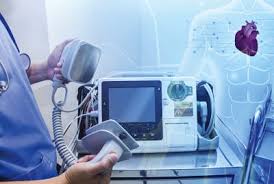- Medical Automated External Defibrillators (AEDs) are essential tools for managing sudden cardiac arrest (SCA), providing a life-saving intervention that can be used in hospitals, clinics, and healthcare facilities. Designed for professional settings, medical AEDs deliver controlled electric shocks to restore normal heart rhythms and guide trained medical personnel with advanced features that enhance CPR effectiveness and patient care.What is a Medical AED?A medical AED is a portable device that automatically diagnoses life-threatening cardiac arrhythmias and can administer defibrillation to help the heart re-establish an effective rhythm. Unlike public-use AEDs, medical AEDs are tailored for environments where healthcare providers or trained professionals may be present, allowing for faster response times and improved accuracy in emergencies.Key Features of Medical AEDs
- Advanced CPR Feedback: Many medical AEDs offer real-time guidance on compression depth and rate, supporting CPR quality. These features are critical in a hospital or clinic setting, where continuous monitoring and optimal compressions can make a crucial difference.Clear Visual and Audio Prompts: Medical AEDs provide audio instructions and visual cues for all steps, from electrode placement to administering shocks. This helps ensure accuracy and enhances confidence, even in high-stress situations.Durability and Reliability: Given the demanding environment in medical facilities, medical AEDs are built for durability and include high-capacity batteries. Many models are designed with features that prevent errors in case of malfunction or when needing to self-test.Data Storage and Transfer Capabilities: Most AEDs intended for clinical environments allow data logging and transfer, which can be invaluable for later analysis and compliance with medical protocols.Self-Testing Functions: Medical AEDs regularly self-test, ensuring they are always ready for use. This automatic check feature is vital to reduce the chance of malfunction during an emergency, as facilities may store AEDs in various units and rooms.
- Emergency Departments: Given the high risk of cardiac cases.Intensive Care Units (ICUs): For quick access during patient emergencies.Surgery Units: To ensure immediate response during or post-surgery.Outpatient Clinics: Especially those handling cardiac patients.
Yes, many medical AEDs are designed to be used by trained individuals, including first responders or bystanders with basic AED training, and can be applied in broader settings outside medical facilities.2. How often should a medical AED undergo maintenance?
Regular checks are necessary to ensure AEDs are operational. Most AEDs are programmed for self-checks, but monthly physical checks and annual servicing are recommended.3. What is the typical battery life of a medical AED?
Battery life varies by model but generally ranges from 2 to 5 years. However, certain high-frequency settings may require more frequent replacements.Conclusion: The Importance of AEDs in Medical SettingsMedical AEDs play a crucial role in saving lives within healthcare facilities. Their design, durability, and advanced functionality make them invaluable assets in providing quick, effective treatment for sudden cardiac arrest. By investing in high-quality medical AEDs like those available from CalMed Equipment, healthcare facilities ensure they are prepared to respond effectively and efficiently when every second counts.For more on medical AED options and professional equipment for your healthcare facility, visit CalMed Equipment’s Medical AED section.

Posted inHealth


